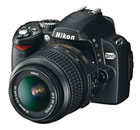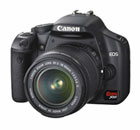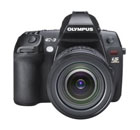
December 02, 2008
Having trouble viewing this newsletter? Read the latest issue online at
https://www.digital-slr-guide.com/dslr-news.html or read back issues
If someone you know has forwarded you this newsletter and you've enjoyed it, subscribe now to receive the next issue when it's published.
DSLR News - November 2008Since the holiday gift-giving season is right around the corner, I'm going to devote this issue of the newsletter to talking about some of the camera options available to you, and some of the strengths of each model.For existing digital SLR owners: if you're interested in the latest gear, then feel free to browse through this newsletter. Otherwise, take some time off and come back in a month for more photographic tips and tricks. When talking about modern digital SLR cameras, it's worthwhile to group them by the level of skill required to operate them. Some cameras are aimed directly at beginning SLR users - those who are frustrated by the slow performance of their compact cameras but who aren't quite ready to jump into the fully manual world of a digital SLR camera. I call these the CONSUMER level cameras. The next group of SLRs are designed for people who want a bit more performance out of their cameras than what the most basic models have to offer. They're called advanced amateurs, professional consumers or PRO-SUMERS for short. They often have some experience taking pictures with an SLR, whether it be film or digital. Next come the SEMI-PROFESSIONALS: people who make income from photography, but have not yet quit their day jobs. Even if you don't want to make money from your photos, cameras built for professional use are rugged and powerful, and they offer plenty of ways to customize camera settings to satisfy a specific shooting style. Finally, there are a cluster of digital SLRs that are exclusively for PROFESSIONAL photographers. While I will sometimes mention these types of cameras in the newsletter and on the site I don't go into much detail. There's a simple reason why: these cameras are very expensive, well out of the range of most consumers. Furthermore, what you are paying for are features and performance geared toward extensive daily use. If you're not planning on using your SLR for big photo shoots in remote locations, then cameras that fall into the more consumer-level bins should suit you just fine. |
In This Issue
Latest SLR Guides
Nikon D60
Canon Rebel XSi
Pentax K20D
Canon 40D
Olympus E-510
Nikon D80
Canon Rebel xTi
Nikon D40
Digital SLR Terms
Megapixels
Stabilization
ISO / Image Noise
Sensor Dust
Crop Factor
RAW vs. JPG
Continuous Photos
Autofocus Points
Aspect Ratio
Lens Terms
Focal Length
Prime vs. Zoom
Maximum Aperture
First vs. Third Party
SLR Lens Features
Canon Lens Glossary
Nikon Lens Glossary
|
SPECIAL - For Sale
This month I've got a Nikon D60 with lens. Next-day shipping ensures you get it before the holidays!Recently Updated
Coming Soon
- Nikon D90 Guide (almost done)
- The Best Digital SLR of 2008
- Full Frame Digital SLRs
- Micro 4/3 Digital Cameras
- Digital SLR Camera Types
Consumer SLRs

They all work quite well in full AUTO mode and they don't require extensive knowledge of digital SLR terms to operate.
An important note: even those these cameras are not quite as fast as their more expensive cousins (where speed is measured by autofocus performance and continuous shot capture rate), any one of these cameras will out-perform a digital compact any day of the week.
Speed is one of the main advantages of making the move from a compact camera to a digital SLR, and you get that peformance increase even if you buy an SLR that is dirt cheap with minimal features.
The cameras that fall into the consumer SLR category are:
| CAMERA | U.S. PRICE |
|---|---|
| Canon Rebel XS (450D) | $480 |
| Nikon D60 | $530 |
| Olympus E-420 | $390 |
| Olympus E-520 | $485 |
| Pentax K200D | $560 |
| Sony A200 | $500 |
The consistent front-runners in terms of overall sales go to the Canon XS and the Nikon D60 (read guide) due in large part to brand-name recognition.
Sony is new to the digital SLR scene (but has gained a lot of market share in a short period of time) while Olympus and Pentax continue to have loyal enthusiasts but don't attract new buyers at quite the same rate as Canon and Nikon.
Here's the quick 30-second comparative analysis for those of you considering a camera in this category:
- The Nikon D60 is not 100% compatible with older Nikon lenses (autofocus won't work)
- All of these cameras capture the same number of megapixels (10)
- The Olympus E-520, Pentax K200D and Sony A200 all have dust control, live view and built-in image stabilization
- Only the Pentax K200D is weatherproof
- The Canon Rebel XS and the Pentax K200D offer the greatest number of lens options (without adapters)
- The Olympus E-420 is the smallest and lightest SLR
Take the Camera Guide Poll - tell me which camera you'd like to see reviewed next!
Pro-Sumer SLRs

Yes, these cameras have full AUTO mode and what are called "Program Modes" (landscape, portrait, macro, action) where you let the camera do all of the "thinking" for you.
Using cameras like this with automatic settings is certainly possible, but it doesn't leverage all that the camera has to offer (and won't generate the best images under challenging conditions).
Where these cameras shine is in their combination of features: allowing you to customize and tweak how the camera captures images regardless of the subject and the amount of available light.
The pro-sumer cameras currently available are:
| CAMERA | U.S. PRICE |
|---|---|
| Canon XSi (450D) | $640 |
| Nikon D90 | $1,170 |
| Olympus E-30 | $1,400 |
| Pentax K20D | $820 |
| Sony A300 | $550 |
| Sony A350 | $700 |
Similar to the consumer digital SLRs, the most popular cameras in this category come from Canon and Nikon: the Rebel XSi and the new Nikon D90.
A testament to Sony's aggressive approach to the digital SLR market is the existence of two cameras in this category, one with a substantial 14 megapixel sensor (the A350).
Let's take a quick look at how these cameras compare:
- The Pentax K20D and the Sony A350 capture the most megapixels (14)
- The Pentax K20D, Sony A300 and Sony A350 all have dust control, live view and built-in image stabilization
- Only the Pentax K20D is weatherproof
- The Sony A300 and A350 have LCD screens that tilt out from the camera body (all other LCDs are fixed in place)
- The Nikon D90 has the fastest continuous capture speed (4.5 photos per second)
- The Nikon D90 is the only digital SLR in this category that also captures video
- The new Olympus E-30 has "artistic" filters that you can apply as you take photos
Get the Most From Your Digital SLR Camera
- Learn digital SLR camera jargon in 5 online lessons
- Master the controls of your digital SLR
- Dramatically improve the photos you take
- Learn at your own pace - review the lessons any time
- NEW! Download all 5 lessons to read on the go
Semi-Pro SLRs

Think of a digital SLR camera like a car: the consumer models are those that are attractively priced and appeal to the widest range of buyers.
The pro-sumer SLRs are like cars with a few more luxury features for those with special needs or special tastes.
The semi-pro cameras that I will discuss in this section are like sports cars: their purpose is to deliver blazing-fast performance - the equivalent of zero to sixty in 8 seconds.
There are two main features that benefit from all this speed: the autofocus (AF) system and the continuous drive.
AF systems in semi-pro cameras are built with professional applications in mind: they assume that you'll be using the camera to take pictures of sporting events, where your subjects are not going to remain still while the camera locks focus.
The fast continuous drive speeds help photographers capture that "defining moment" - the one shot in a sequence of images that really stands out from all the rest.
A quick comparison: cameras in this semi-pro category have continuous drives speeds that are twice as fast as their consumer and pro-sumer counterparts.
Of course, you pay a premium for all this speed and performance, just like a sports car.
Let's take a look (prices listed are for the camera WITHOUT a lens):
| CAMERA | U.S. PRICE |
|---|---|
| Canon 40D | $840 |
| Canon 50D | $1,099 |
| Nikon D300 | $1,550 |
| Olympus E-3 | $1,300 |
| Sony A700 | $1,000 |
Performing a detailed analysis of these cameras is more than I have time for in this newsletter - once you start comparing features you'll realize that each one of these cameras has a lot of strengths and relatively few weaknesses.
I've often found when discussing these types of cameras with photographers that a lot comes down to brand name recognition and/or loyalty.
For example, if you've been diligently using an older Olympus digital SLR (and own an Olympus compact camera) then the E-3 will appeal to you on many levels since it has a blazing-fast autofocus system, is weatherproof (rain? who cares?) and is the ONLY digital SLR in this category with an LCD that flips out from the camera body for high and low angle shooting.
On the other hand, if you've got a large collection of Nikon lenses that you've used for years with your Nikon film SLR, then the obvious choice is the Nikon D300 with its 51-point autofocus system, advanced light meter and an ability to capture 8 photos per second (when used with the MB-D10 battery grip).
Finally - and this is an important one - don't just pick up a camera in this category because you think it's the best or because a salesman tells you so.
Yes, these cameras are the best (with the exception of the pro models) - that's why they cost so much.
But before you plunk down your hard-earned money for such a camera, make sure that you're really going to leverage all that speed and power. If you have no intention of taking your camera on a regular basis to photograph high-speed action, then one of the pro-sumer or consumer cameras will suit you just fine (and will save you a lot of money that you can spend on great lenses!).
Where to Buy Your SLR
One of the best ways to make a final decision about which camera is right for you is to spend some time in a camera store and actually hold the cameras in your hands.Holding the camera and using some of its features will give you a sense of how the camera feels and whether it's a good fit for your hand.
Some of the small-sized digital SLRs are great for people who don't want a large heavy camera, but the grips can be uncomfortable for anyone with long fingers or larger hands.
Once you've had the opportunity to play around with a camera and have found "the one", then the only remaining issue is whether you should buy it from a retail store or online.
I'll admit that every piece of camera equipment I have ever owned has come from an online store. When I have compared online prices with retail outlets I consistently find that prices are better online.
However - and this is a BIG however - you have to be very careful when purchasing gear from an online retailer that you're not familiar with.
There are plenty of web sites out there selling camera gear that look perfectly legitimate, but are really just fronts for scam operations. The sites lure you in with an incredibly low price (often about half of other stores) and then - once they have your payment - they lead you on a run-around and don't deliver the item that you've paid for.
Here's the easiest way to tell if an online dealer is reputable: just go to Google or Yahoo and type in "[store name] complaints". For example, if the store is bestcameradeals.com then you'd enter "bestcameradeals.com complaints".
If the online retailer is really just a scam operation, you'll find out pretty fast (and will save yourself a lot of frustration from having to deal with one of these companies in the process).
Since I'd rather not take my chances dealing with a company that I am not familiar with, there are really only three sites where I purchase camera equipment: Amazon, Adorama and B&H Photo Video.
These sites are secure, reputable and have great return policies in the off chance that your camera arrives dead in the box.
Photo Links
Other Photography Sites
- Betterphoto.com - a wealth of photography learning opportunities
- Photojojo - tons of photography do-it-yourself (DIY) projects
- Flickr - share your photos with friends and others
- Strobist - everything you ever wanted to know about lighting with external flash
- Photo.net - plenty of learning resources and examples of exceptional photography
In Conclusion
What with family illness and the holidays I haven't had as much time to devote to the site as I'd like.I will update as much as I can in these first weeks of December, to ensure that the information that you're getting from the site is as current as possible (especially if you're using it to make a final decision).
If you do happen to note errors, inconsistencies or things that are just plain out-of-date, then please feel free to contact me and let me know the page and the information that doesn't appear to be correct.
I'll add it to my to-do list and will try to get it corrected before the end of the year.
Until then, happy picture-taking!
--Chris Roberts, Your Digital SLR Guide